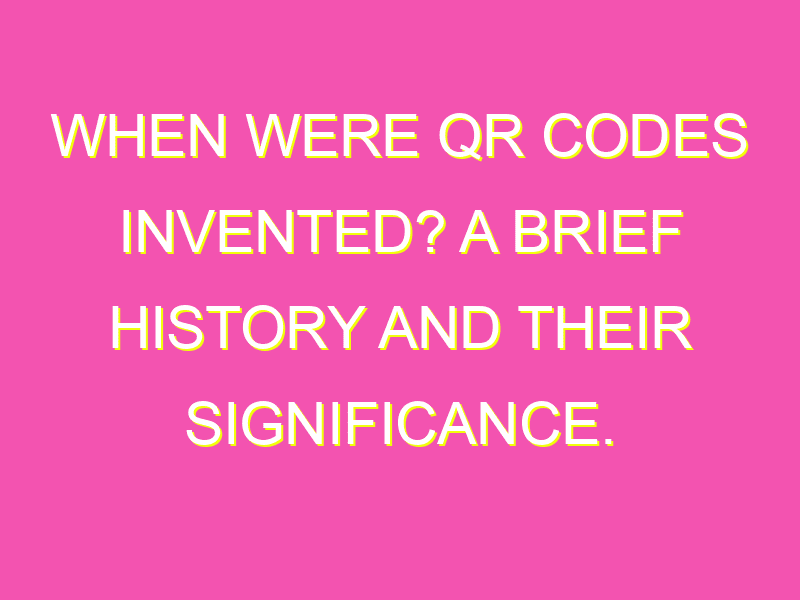Are you tired of typing in long URLs to access websites or social media pages? Cue the hero of this story: QR codes! These small, square codes pack a punch as they were designed to store more information than traditional barcodes. Let’s dive into some interesting facts:
Whether you’re a marketer, artist or business professional, incorporating QR codes into your work can enhance engagement and provide a unique experience for your audience. QR codes – small, yet mighty!
QR Codes: A Brief History and Their Future Implications
The Concept of QR Codes
QR codes, or Quick Response codes, were first developed in the mid-1990s by Denso Wave, a subsidiary of Toyota. The goal of QR codes was to create a more efficient way of storing and retrieving information. QR codes are two-dimensional barcodes that can store up to several hundred times more information than traditional barcodes.
Denso Wave designed QR codes to be easily scanned and decoded using a smartphone camera, making the process of retrieving information much faster and more convenient for consumers.
Today, QR codes have become an integral part of many industries, including retail, automotive, and healthcare. They are also often used for marketing purposes, providing a quick and easy way for consumers to access promotions or discounts.
Development of the First QR Code
The first QR code was developed by Denso Wave in 1994. The team at Denso Wave sought to create a code that could be quickly and easily decoded, even when printed on curved surfaces or at high speeds.
The QR code was designed to be more robust than traditional barcodes and could store significantly more data. Using a dense matrix of black and white squares arranged on a grid, the QR code could store up to 7089 digits, 4296 alphanumeric characters, or 1817 bytes of binary data.
Denso Wave released the QR code to the public in 1999, and it quickly gained popularity in the automotive industry.
QR Codes in the Automotive Industry
QR codes initially found their widest adoption in the automotive industry. Car manufacturers like Toyota began using QR codes to track vehicle production on assembly lines, but soon found other uses for the technology.
QR codes were used to store information on car parts, making it easier for mechanics to diagnose and repair issues. QR codes were also placed on brochures and ads, allowing customers to quickly access information about particular vehicles.
Major Advances in QR Code Usage
In the early 2000s, QR codes began to gain traction in other industries. Retailers began using QR codes to promote in-store sales, while healthcare professionals used them to store patient information. By 2011, QR code usage had become widespread, and companies began experimenting with more creative ways to use the technology.
One example of this is the use of QR codes on billboards and other outdoor advertisements. By scanning the code, users could access additional information or multimedia content related to the ad.
Another major development was the use of QR codes in mobile payments. In China, companies like WeChat and Alipay allow customers to make payments using QR codes. This has revolutionized the way businesses accept payments, making it more convenient for both customers and merchants.
QR Codes and Smartphone Technology
The widespread adoption of smartphones has been a major catalyst for the popularity of QR codes. With most consumers now carrying a smartphone in their pocket or purse, scanning a QR code is now easier than ever.
Most smartphones now come with built-in QR code scanning capabilities, eliminating the need for consumers to download a separate app. This has made QR codes a more accessible and user-friendly technology.
Future Implications of QR Codes
As technology continues to advance, it’s likely that QR codes will continue to evolve as well. One potential development is the use of QR codes in augmented reality (AR) applications. By scanning a QR code, users could access AR content related to a particular product or service.
QR codes could also become more integrated with voice-activated assistants like Google Assistant or Amazon Alexa. By scanning a code, users could access more detailed information or make purchases using only their voice.
Popularity and Widespread Adoption of QR Codes
As of 2021, QR codes have become a ubiquitous technology around the world. They are used by businesses and individuals alike for a wide range of purposes, from product promotions to mobile payments.
The COVID-19 pandemic has also spurred new uses for QR codes. Many restaurants and businesses now use QR codes to provide contactless menus, reducing the risk of COVID transmission.
Overall, QR codes have come a long way since their inception in the 1990s. They have become an integral part of many industries, and their versatility and convenience have made them a popular technology with consumers. As technology continues to evolve, it’s likely that QR codes will continue to adapt and find new uses in a wide range of applications.





